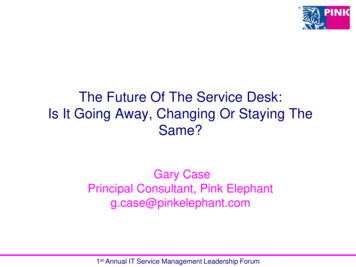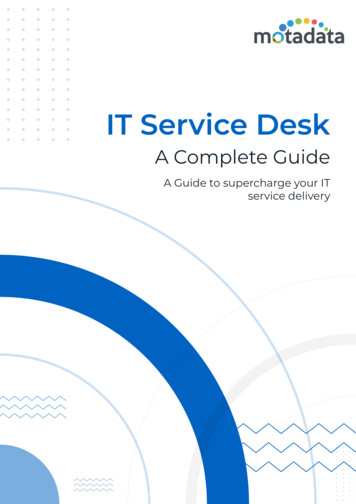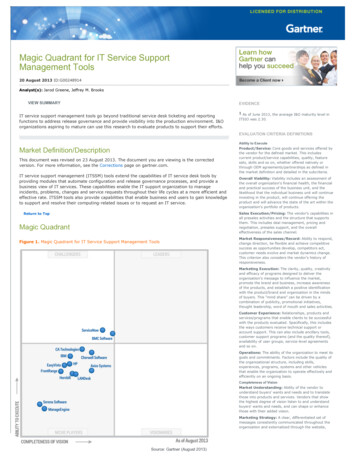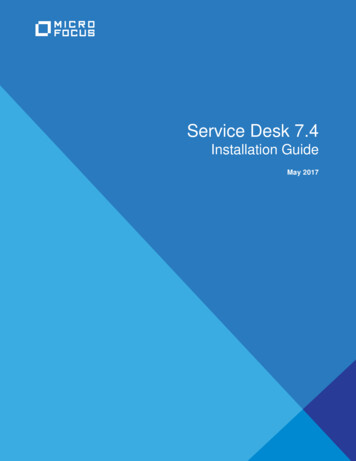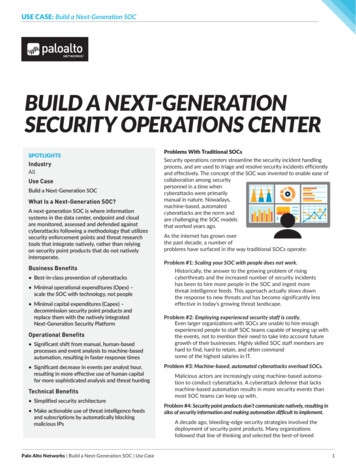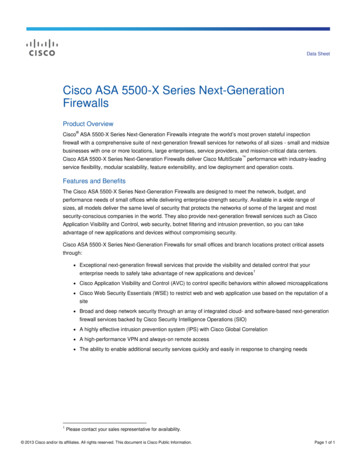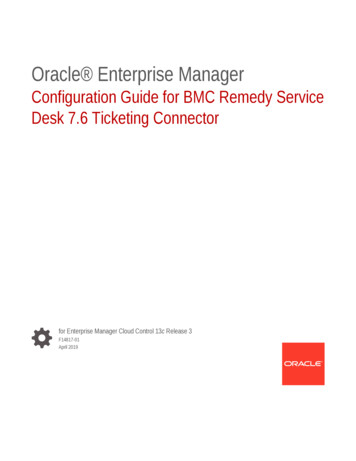
Transcription
THE WHITE BOOK OF.The NextGenerationService DeskThe definitive guide tobuilding a Service Deskfor the digital era
THE WHITE BOOK OF.The Next-Generation Service DeskContentsAcknowledgements 04Preface 05Executive summary 07Introduction: A changing Service Desk environment 101. A new Service Desk mission 122. Understanding users 183. The proactive Service Desk 224. The role of automation 28Conclusion: The Service Desk of tomorrow 343
AcknowledgementsWe would like to thank the following individuals for their valuable contributions to our research:ll Neil Archer, Head of Enterprise Service Management, British American Tobaccoll Daisuke Honda, Head of Service Desks, Global Delivery, Fujitsull Patrícia Carrusca, Project Manager, Service Desk Line of Service, Global Delivery, Fujitsull Karyn Jeffery, VP and Head of End User Services, Global Delivery, Fujitsull Andy Mears, Global Head of Technical Maintenance Services, Global Delivery, Fujitsull Carey Blunt, Global Chief Architect for Service Management Tools, Global Delivery, Fujitsull Mike Matthews, EMEIA Service Desk and Integrations Offering Manager, Fujitsull Ivar Fennema, Senior Solution Architect, Fujitsull Malcolm Fry, independent IT service management expertll Charles Araujo, Director, Principal Analyst with Intellyx and Founder of the Institutefor Digital Transformationll Fola Aiyeola, Senior IT Analyst, QBE Insurance Groupll David Dauphinais, Service Delivery & Business Infrastructure Manager,Saint-Gobain Technology Servicesll Ollie O’Donoghue, Head of Research and Insight, Service Desk Institutell Steve Watt, Chief Information Officer, the University of St Andrewsll Panu Vehniäinen, Director, YIT Information Services4
PrefaceBuilding a Service Desk fit for the digital eraThe white book of the next-generation Service Desk is the seventhinstalment of Fujitsu’s white book series, which delivers practical,forward-looking guidance to enterprises on how they can transformthe support they provide to meet the needs of the digital age.The changing role of ITFor many organisations, the rapid rise of digital has pushed IT to the topof the corporate agenda – transforming it from a cost-centre to strategicenabler. Across industries, businesses are using emerging technologiesto transform their business, move from product-based to service-basedmodels, and respond quickly to new trends in the marketplace. Without ahigh degree of digital dexterity, today’s firms simply cannot compete.Heightened user expectationsAnd, just as the role of IT has increased, so have employees’ expectationsof IT support. Businesses today face a stark reality: employees are havingfantastic experiences with the technology they use in their personal lives,but this isn’t always matched in the workplace. Initiatives such as “bring yourown device”, “choose your own device” and “corporate-owned, personallyenabled” are one way in which employers are seeking to address staffdissatisfaction with technology – but this is only a partial solution.Organisations must also provide staff with the same standard of IT supportthat they receive with consumer IT. For the Service Desk, this poses a uniquechallenge. How do you deliver an outstanding user experience in an increasinglycomplex IT environment, where people work at any time, in any place,and on any device?Our experience shows that there are a number of ways in which the servicedesk must evolve to meet the demands of today’s users:ll Provide an omni-channel service. This means allowing employees to accessIT support through their preferred channel, wherever they are and whateverdevice they are using.ll Become genuinely end-user-centric. The Service Desk must deliver apersonalised experience that reflects the employee’s role and capability, andempowers them to use IT effectively in order to achieve business targets.5
ll Shift from being reactive to proactive. Rather than respondingto issues flagged by users, the Service Desk should use cloudtechnology and advanced data analytics to identify and mitigateissues before they become widespread.ll Identify new ways to create business value. Instead of focusingon cost savings, the Service Desk will increasingly be expectedto identify new ways to improve the customer experience, boostinnovation and drive business value.Above all, it’s clear that the role of the Service Desk is no longer simplyabout fixing and fulfiling. It’s about enabling the people we serve: ourend users.Proactive, predictive, personalThe Service Desk has become the shop window for IT – andwith this responsibility comes opportunity. Advanced machinelearning and big data technologies provide the capability totransform Service Desks into a proactive function, which providespredictive, personal and dynamic insight across Service Deskactivities. Indeed, it is predicted that use of autonomics andcognitive platforms could drive a 60% reduction in the cost of ITservices, enabling organisations to apply human talent to higherlevel tasks that require creativity, curiosity and innovation.We hope this book will help businesses and IT leaders ontheir journey towards transforming their Service Desks fora digital age: into a more proactive function that providespredictive, personal and dynamic insight across the business.As ever, we welcome your feedback and insights.Daisuke HondaHead of Service Desks, Global Delivery, Fujitsu6
Executive summaryThe Service Desk’s mission is changingTechnology has moved out of the back office to become a critical businessenabler. This shift is increasing the pressure on the Service Desk toprovide a faster, more flexible service that better responds to the needsof users and their organisations. Meanwhile, the relationship workershave with technology is changing as consumerisation has altered users’expectations of the IT support experiences they should receive at work.Furthermore, the growth of cloud technology and shadow IT, together withinitiatives such as “bring your own device” (BYOD), “corporate-owned, personallyenabled” (COPE) and “choose your own device” (CYOD), means the Service Deskno longer has full control over the systems and technologies it supports.As organisations derive increasing value from technology andcontinue to invest heavily, the Service Desk must develop thecapability to support whatever technologies the business has chosento use at any given point. And IT preferences are likely to changefrequently as the digital environment continues to evolve.In this report, we explore how the Next-Generation Service Desk will fulfilits new mission by harnessing emergent technologies and adoptingnew, innovative approaches. Concepts covered include the following:ll The Next-Generation Service Desk will be user-centric. The Service Deskwill need to make the “user experience” its first priority. This includesrecognising users as customers and building strategies that supportand enhance users’ professional activities in the first instance.ll The Service Desk will be proactive and invisible. Rather than reactingto issues as they occur, the Service Desk will have to work harderto minimise disruption to user productivity – by anticipating andpreventing IT issues in a non-invasive fashion, before they arise.ll Intelligent use of data and analytics is essential to understand theIT environment. Using new analytics and monitoring technologies,the Service Desk must learn to harness data from users and thewider work environment. Staff will need to interpret and linkinformation intelligently to foresee problems and opportunities.7
ll Automation is here to stay. IT service managers have learned frompast failures: automated Service Desk processes will be central totheir strategies in future. As well as improving the user experienceby providing an instant response to queries and issues, automationwill help to lower the workload of the Service Desk and drive costsavings through reducing the need for human intervention.ll Machine learning and artificial intelligence (AI) will be criticalcomponents of the next-generation Service Desk. Building on the earlysuccess of virtual agents, AI and other forms of machine learning willultimately be able to handle much of the Service Desk work volume.ll There will always be a place for Service Desk staff. Rather thanreplacing human representatives, automation will free staff fromlower-level tasks to focus on higher-level functions and assumevalue-adding, business-facing roles. This hybrid approach will allowfor a more rounded and holistic technology user experience.8
9
Introduction: A changingService Desk environment“We have to cater tothe whole continuumof end user. At oneend of the spectrumwe have 18-year-oldswho are extremelytech-savvy – havingbeen brought upwith social media.At the other end wehave employees whoare digital novicesand see IT as a wayof getting by.”Steve Watt, ChiefInformation Officer,University of St Andrews10IT departments no longer have a monopoly on digital knowledge.Having once been confined to the back office, technology is nowpivotal to driving growth in almost all areas of an organization– from resource management to sales and marketing.“Technology is one of the few remaining sources of competitivedifferentiation in the marketplace,” says Charles Araujo, Principal Analystwith Intellyx and Founder of the Institute for Digital Transformation.“If I don’t understand how technology impacts my job and mybusiness goals, then I’m putting myself at a huge disadvantage.”As organisations hold a greater appreciation of technology andits role in driving the business, IT departments are also havingto contend with the greater digital dexterity of users. “Techsavvy” employees are penetrating the workforce in ever-greaternumbers1, and millennials, born between 1980 and 20002, havebrought with them new attitudes towards using technology.IT must cater to the demands of a younger workforce: digitalnatives who are increasingly comfortable with using technologyand reliant on it in their personal lives. For this growing cohort, ITsupport is no longer just a service but also an experience – onenow measured against the ever-more sophisticated solutionsthey can access in the world of consumer technology.1. on-in-u-s-labour-force2. lennials/
“People expect to receive the same experiences and level of service whenthey come into a business environment,” says Mike Matthews, EMEIA ServiceDesk and Integrations Offering Manager at Fujitsu. “They want to accesstechnology and services 24/7, from wherever they happen to be.”Faced with changing expectations from various sides of the business, and alreadyunder pressure to reduce costs and headcounts, the Service Desk must redesignthe methods it uses to offer support to customers and understand their needs.Users want support, but on their own termsIT organisations have sought to empower technology users and to cater to their changingbehaviours and needs. Through BYOD, CYOD, COPE and other initiatives, users have beenallowed greater freedom to pick and choose the devices and software they use at work.Furthermore, organisations are realising that they need to adapt the way in which theydeliver IT support to employees. Though still in widespread use in most organisations,traditional telephone and email-based support channels have failed to keep pace with theconsumer experiences that younger audiences have come to expect in their personal lives.“Younger audiences want to self-serve, and they don’t want to interact with a humandirectly unless they absolutely have to,” says Carey Blunt, Global Chief Architect for ServiceManagement Tools at Fujitsu.Araujo agrees: “As you move across the generational landscape, people are turning to theirpeers to solve technology challenges. They reach out to each other – they post on Facebook.”IT departments are adapting their delivery strategies accordingly. As the use ofemail and voicemail-based support channels have started to fall into disuse, newsupport options are taking their place, including social media portals, live-chatplatforms and virtual assistants3. At the same time, however, IT organisationsmust continue to meet the needs of “digital novices” – older users who lack thedexterity and curiosity of younger workers in using new technologies.As technology continues to evolve and the needs of organisations and their employeesbecome more disparate and complex, the Service Desk faces a mounting challengein trying to satisfy the demands placed on it. So how can the Service Desk ensurethat it is taking the right approach to meeting today’s fast-changing needs?As technology continues to evolve along with the workforce it serves, the ServiceDesk has had to find new ways to resource itself and fulfil its mission. To date,these solutions have brought varying degrees of success. So how can the ServiceDesk ensure it has the right approach to meet today’s fast-changing needs?3. eport11
1A new servicedesk mission12
1A new Service Desk missionThe Service Desk is having tomake the transition from problemsolver to business enablerTechnology is not only essential to the day-to-day running of organisations,but it has also become a source of competitive advantage in themarketplace. Cloud computing, data analytics and software developmentare increasingly forming an integral part of companies’ product developmentand playing a key role in how companies IT service managers havelearned from past failures: automated Service Desk processes will becentral to their strategies in future products and services to market.By harnessing cloud computing software and other technologies,organisations can also streamline their operations and reduce costs.As such, investment in technology continues to accelerate significantly:a recent report from International Data Corporation (IDC) projects arise in corporate IT spending to 2.8 trillion worldwide in 20194.“The Service Deskhas evolved fromplaying an IT-centricrole to assuminga technologysupport role withinthe business.”Charles Araujo, Director,Principal Analyst withIntellyx and Founder ofthe Institute for DigitalTransformationAgainst this backdrop, the role of IT departments has becomeincreasingly critical, helping to update and moderniselegacy systems while also integrating externally developedsoftware and applications into the workplace.“The modern corporate IT environment is moving towards becomingan amalgamation of many different solutions,” says Steve Watt, ChiefInformation Officer, the University of St Andrews. “A lot of our services aredelivered by cloud providers. Rather than managing internal platforms,we are working with the Service Desks of various other entities.”Meanwhile, an increasing reliance on technology is placing greaterdemands on Service Desks and the IT departments that house them.“If you ask companies what the most critical service to keep runningis, it’s their email, their online connectivity,” says Malcolm Fry, anindependent IT service management expert. “Service Desks are havingto make decisions that bear enormous consequences for the entirebusiness. IT staff are making 50 to 60 of these mission-critical decisionsa day. No other part of the business has this level of responsibility.”Clearly, the Service Desk mission has moved beyond simply overseeingand fixing day-to-day IT issues to acting as a critical enabler oforganisations’ technology operations and as the last line of defencefor when things go wrong.4. https://www.idc.com/getdoc.jsp?containerId prUS4100651613
“The ‘bring yourown device’phenomenon isreally just a taste ofwhat’s to come – itwill soon be a caseof ‘bring your owneverything’. You nowsee users wanting towork with their ownsoftware and findingways to bringthis into the workenvironment.”Ollie O’Donoghue, Headof Research and Insight,Service Desk Institute“In the past, theService Desk waslooked at as an ITorganization thatfixed problems. Now,we’re being heldto account on howfast we can resolveissues and the valuewe can bring to thebusiness.”Mike Matthews, EMEIAService Desk andIntegrations OfferingManager, Fujitsu14New approaches, mixed resultsBut this shift has not always been reflected in the resourcesand tools awarded to Service Desk staff. While technology isbeing put to greater use in organisations than ever before, itsadoption is still largely overseen at the boardroom or C-suitelevel – often by those with non-specialist backgrounds5.In order to contend with the changing technology landscape,organisations have developed new strategies and approachesaround IT service management to give users greaterflexibility and choice in shaping their experiences.But not all of these steps have been taken with the best interests of theService Desk or its customers in mind, and while cost containment ofService Desk operations is a necessary reality as organisations increasetheir technology spend, it has often been to the detriment of the supportdelivered to IT customers. “In the 1990s there was a lot of focus onstandard SLAs [service level agreements] that looked to save time andcreate efficiencies, rather than focusing on user satisfaction,” says AndyMears, Fujitsu’s Global Head of Technical Maintenance Services, GlobalDelivery. “Quite often it was a case of reducing time on calls or movingthe user on, instead of focusing on the user experience or the outcome.”By overlooking the needs of technology users in the first instance,organisations stand to undermine the professional operations ofemployees and the wider business. By causing frustration with poorIT user experiences, they also jeopardise the retention of workers.And while outsourcing IT service management or shiftingoperations overseas can offer business benefits, there is a riskthat this will place further obstacles between the Service Deskand its customers. “Communication is so important,” says FolaAiyeola, a senior IT Analyst at QBE Insurance Group. “The way youwould talk to an IT customer in Germany is very different fromthe conversation you’d have with an employee in India.”More recently, strategies that focus on moving IT issue resolutioncloser to the organization’s front line, such as “shift-left”, have aimedto reduce the pressures on desks by enabling users to resolve low-levelissues themselves through self-service portals. Again, these initiativeshave not always been designed around the needs of users in thefirst instance and have faced resistance from workers as a result.5. -board-pushes-emerging-area-of-tech-governance/
1“What we’ve seen historically is a decision by IT departments tointroduce extra functionality through a portal or a website, withoutconsidering the people who are actually using these platforms,” saysFujitsu’s Carey Blunt. “People want choice. There are still digital noviceswho much prefer to have the human contact on the phone.”Moreover, the increasing reliance on self-service portals and othermodern IT support strategies may have further impeded communicationbetween the Service Desk and end users and the exchange of informationbetween the two. Without this direct contact, it becomes harder for ServiceDesk staff to understand their customers and their requirements.From reactive to proactiveA new Service Desk mission“The goal of ServiceDesks should beproactive intervention–monitoring potentialproblems andeliminating them atsource rather thanreacting to them oncethey’ve arisen.”Andy Mears, Global Head ofTechnical Maintenance Services,Global Delivery, FujitsuOrganisations are recognising the need for a user-centric approach to ITservice management – one that positions the needs and activities of usersalongside cost containment and other objectives as key priorities. “Ourmain concern is the end user and their productivity,” says Daisuke Honda,Head of Service Desks, Global Delivery at Fujitsu. “This is core to our visionand strategy and it is reflected in the investments we make. Our goal is notto get staff away from an agent, it’s to have the user mediated as quicklyas possible – enabling users to access support through their preferredchannels and delivering a complete and personalised support experience.”According to Karyn Jeffery, Fujitsu’s Vice President and Head of End UserServices for Global Delivery, the Service Desk mission when taken to itslogical extension should be preventing IT issues from being allowed todisrupt the work of technology users in the first place. “This is the nirvanaof shift-left,” she says. Rather than reacting to incidents as they occur, theService Desk should focus on proactive intervention, with staff using theirresources to anticipate and eliminate potential issues before they arise.In adopting more proactive and forward-thinking approaches, the role of theService Desk can become better aligned with the core business objectives ofthe wider organization. Rather than simply being left to troubleshoot IT issues,the Service Desk should be recognised as an important business enabler inits own right. From helping organisations to absorb new technologies andminimise potential disruption to maximising employee retention, ServiceDesks clearly have critical roles to play in their organisations’ futures.15
“Big data andanalytics willsignificantlyenhance the servicemanagementenvironment. Thesetools will allow ITorganisations togather businessintelligence aroundtheir customers andto push the rightservices towardsend users. IT supportwill become farmore personalisedand effectivebecause of this.”Ollie O’Donoghue, Headof Research and Insight,Service Desk InstituteWhat will the Next-GenerationService Desk look like?The next few years look set to be a period of immense change for theService Desk industry as the corporate IT world embraces new technologiesand new approaches. The next-generation Service Desk will Offer business value through innovationManaged services offerings that make use of autonomics and cognitiveplatforms will allow the Service Desk to deliver greater value – byempowering users, driving productivity and growing revenues.The growing use of virtual assistance models offers a glimpse of whatthe IT user experience will look like in the future. With AI and machinelearning technology developing apace, virtual or cognitive agents will bekey features of the Service Desk landscape within the next 5-10 years.In time, virtual assistants will become the main interfacewith which end users interact with the online world; agentswill act as proxies for human staff, providing customers withpersonalised and “human-like” IT support experiences.59% of Service Desks see the use of automationas a top priority.Service Desk Institute surveyBe proactive and data-drivenBig data technologies will allow IT organisations to develop amuch stronger understanding of the technology environment aswell as the needs and preferences of Service Desk customers.The cognitive computing industry will be worth 15.3 billion in 2019; the predictive analytics marketwill comprise 6.5 billion of this.Allied Market Research; BCC Research165. -board-pushes-emerging-area-of-tech-governance/
1A new Service Desk missionBy embracing predictive analytics and advanced data monitoringstrategies, organisations will be able to tackle IT issuesproactively and pre-emptively and in a non-invasive manner.47% of Service Desks see increased demandfor business intelligence and big data in theimmediate future.Service Desk Institute surveyMake the best use of human talentIntelligent deployment of machine-learning technologies andautonomics will see human talent assigned to higher-level tasksthat require creativity and innovation.73% of Service Desks expect existing staffingmodels to change.Service Desk Institute surveyWith most basic day-to-day IT support functions undertakenautomatically, Service Desk representatives will deliver valuein other ways – by helping to develop intelligence aroundtechnology usage across all levels of the business.17
2Understandingusers18
2Understanding usersBy harnessing big data and analytics, theService Desk can better understand usersand prevent problems before they ariseTo develop a proactive, user-centric approach, organisations mustfirst work to improve their understanding of technology users.Panu Vehniäinen, Director at YIT Information Services, questionswhy organisations rarely attempt to understand internal IT usersto the same extent as they do with their business customers.“The more you know about the person on the other end of the line, themore accurate and efficient the solutions you can offer them become,”explains Vehniäinen. “When a business customer picks up the phone tocall someone managing their account, their history and profile flashesup on a screen. Why isn’t this the case with our IT customers?”As Vehniäinen underlines, viewing technology users as customers ratherthan employees in the first instance is a crucial first step in being ableto offer them the IT support they need. If organisations lack knowledgeabout their IT users, it may be because their approach to gathering andharnessing user-based data has not been developed sufficiently.According to a recent LANDESK and Service Desk Institute (SDI) ServiceDesk benchmarking report, only two-thirds of Service Desks currentlyintegrate user feedback into service improvement plans, while onein ten have no method of measuring user satisfaction at all6.In other cases, organisations have made the practice ofcapturing and analysing user information a labour-intensiveundertaking, the result of which is that Service Desks are notmaking the most of the information available to them.“We use metricsto drive how weresource ourselvesbest. If we’re seeinga cluster problemin a particular areaall relating to Wi-Fi,is it a buildingspecific issue, oris it a coverage orcontention issue?”Steve Watt, ChiefInformation Officer,University of St Andrews“Some Service Desks are only harnessing a small portion of thereporting data they have available to them,” says Fujitsu’s Andy Mears.“Companies often have people trawling manually through vast quantitiesof information and reports. Desks aren’t spending enough timeinterpreting this information, so they aren’t getting the full benefit.”As Mears explains, rather than reducing the burden on the ServiceDesk, current practices commonly employed for measuring userdata – for example manually reading user tickets and trackinguser activity – can create more work for IT support staff.6. LANDESK and SDI Benchmarking Survey 201519
Technology can simplify this process considerably. Interactive dashboards andother Service Desk management tools can help staff to quantify desk performance,including response times and user satisfaction levels. This can help them to evaluateend-user data more efficiently – and deliver more relevant solutions as a result.Data, data everywhereWhile ticket data represents a useful resource in being able to evaluateand improve IT service delivery, many organisations are only scratching thesurface of the information that is available to them. After all, retrospectiveticketing data only takes into account IT issues noticed or reported byusers, while ignoring the many problems that go unseen each day.According to QBE’s Fola Aiyeola, the data coming into the Service Desk will oftenonly provide a cursory understanding of the IT issues users face and why they areoccurring. “I think one of the main difficulties many Service Desks face is havingthis understanding of the technology environment,” says Aiyeola. “It’s easy tosee that someone has a problem with a device or a piece of software, but noone is asking the deeper question – why the issue is occurring in the first place.”Andy Mears believes that organisations should be taking advantage of the widerenvironmental data available to them. “We have access to machine data, andwe have the environmental data around it,” he says. “We also have social mediadata, historical data and repair data. We need to be capturing this information,interpreting the data and time-stamping it, and then linking it all together.”Increasingly, IT organisations are starting to take advantage of new datamonitoring and analytics technology to gain a richer understanding ofthe work environment and the needs of end users. Patrícia Carrusca,Project Manager, Service Desk Line of Service at Fujitsu, outlines how thecompany is monitoring technology users and drawing conclusions fromthe findings. “All user devices are connected to the network and thereforetheir systems can be monitored for their benefit,” she explains. “Thesetools allow us to measure users’ experiences with the network, devices andapplications, allowing us to troubleshoot and actively work on prevention.”By grouping user data, Service Desks can create economies of scale, creatingsolutions and strategies for the wider workforce rather than simply resolvingindividual IT issues. This involves linking data on individual user behavior to gaina rounded picture of the end-user experience, including how recently introducedand externally sourced technologies are interacting with the work environment.20
2Understanding users“We are able to monitor the workplace’s baseline performance over alonger time period to see the impact of changes to the organization’stechnology infrastructure,” says Ivar Fennema, Senior Solution Architectat Fujitsu. “We can make general recommendations for hardwareupgrades or replacements based on actual user requirements.”By grouping user data in this way, organisations can gain insightsinto user behavior that are both broader and more in-depth.New knowledge, new powersAs analytical technologies evolve and become more widespread, they wil
In this report, we explore how the Next-Generation Service Desk will fulfil its new mission by harnessing emergent technologies and adopting new, innovative approaches. Concepts covered include the following: l The Next-Generation Service Desk will be user-centric. The Service Desk will need to make the "user experience" its first priority.



